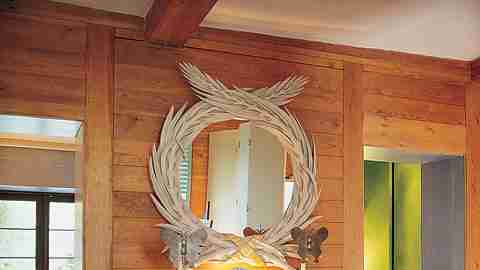An English Merger
View Slideshow

Nostalgic but not sentimental" is how John Stefanidis describes himself, and it is an apt distinction when discussing the process of consolidating the contents of his former two houses into this, his new home. Born to Greek parents living in Egypt, the interior designer migrated to London in 1967 and has lived there ever since. "London is such a metropolis," he says, "bursting with talent, which it certainly wasn't thirty- four years ago. You can get the best craftsmen in the world, and at the same time there's been a great renaissance in the manufacturing of luxury goods, and all this is conducive to one's creativity."
For this house, in Notting Hill, Stefanidis became his own client, doing for himself what he routinely does for others: making sense of space, integrating the new with the existing. (A selection of his international projects is documented in John Stefanidis—Designs, a book to be published next spring.) The past, souvenirs of far-flung travels and the residue of an international life rich in friends and art, suffuses every room without overwhelming the present. The antique and the contemporary coexist in a seemingly effortless harmony that has come to be the designer's signature.
Nostalgic, to Stefanidis's way of thinking, means "you think about the past with affection, but you don't mind that it's over." It was without regrets that he left his house overlooking the Thames and his country retreat in Dorset, each a residence of some twenty rooms; he'd lived in them for twenty years. "The time had come," he says simply. He kept his residence in Greece, where he spends six weeks or so a year. But the rest of the time, he explains, he wanted freedom from the responsibilities that large properties inevitably entail.
He found the house, probably built in the eighteenth century, through a friend. "I'd looked at so many," he remembers. "Yet I just suddenly knew that I could live here. It needed complete reinventing. But that's one of the things I'm good at—I can tell what something is going to be." He was drawn by the possibility of creating an enfilade from the sitting room facing the street through the inner courtyard to the dining room and the garden beyond. "Even though it's a small house, you can see all the way through, which gives you a feeling of space," he says. "What's unexpected is the garden, which is very, very long but very, very narrow." In addition, the windows are positioned in such a way that the light enters from opposite sides of the rooms. "Cross light and enfilade," he declares, "are two things I'm really keen on."
Stefanidis gutted the house and started over, keeping only the pine paneling in the entrance hall and the living room fireplace's grate. Working with a set of plans, he determined what furniture he could bring in. As in many London houses of the period, the rooms were irregular; for example, one wall in the living room was bowed, and there were few right angles. "Some things fitted physically but not in any other way," he recalls. What survives is "a complete mixture," a selection of pieces culled from both the city and the country, "and not necessarily the most valuable ones, just what suited."
Stefanidis's books are everywhere. They were, he says, his first priority in the house's redesign. The downstairs library, its cerulean-blue walls overpainted with blue squiggles, and another, smaller library upstairs, its walls covered with red silk moiré, typify Stefanidis's assured use of color. "I don't believe one can have prejudices about color," he says. "All colors are worthwhile. It's terribly easy to have good-taste schemes, but that's boring. You only need to look at any modern art and see how the colors clash—think of the colors there are in a Picasso. You can achieve a sense of uniform brightness, a sense of comfort with color.
"The light in London changes in the autumn," he adds, "and then the summer colors become quite wrong." For much of the furniture, Stefanidis made slipcovers, which are used in summer. When the weather is warm, the dining room opens to the outdoors. Its slate floor is a continuation of the stone in the courtyard, where a soothing waterfall exits from a slit in the wall, and the garden terrace, planted with box hedges, camellias, fruit trees, clematis and Japanese wisteria, much of it brought from his garden in Dorset. "So I haven't given that up," he says.
A still life on the wall in the living room depicts a scene from one of John Stefanidis's prior houses. Among the objects in it are a vase, since transformed into a lamp, and a Cartier clock, both of them now on the table in the corner; a brass Cloud table, of Stefanidis's own design, now set to one side of the sofa; and a sculpture, which is downstairs. "Later in life," he says philosophically, "you realize that there are things that have become a part of you." Not that he has clung to these things, he insists. Far from it. Instead, he finds that "certain things cling to you, really."